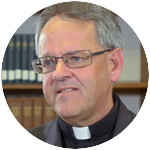
Father Thomas Dailey, O.S.F.S.
The pandemic perdures. With it, devotion has gone digital.
The metrics are still being measured, but anyone with a Facebook feed can see that online liturgical actions have proliferated.
Kudos to the clergy and the curators. The pastoral creativity of the former and the technological prowess of the latter have combined to proclaim the Gospel anew via the means of social communications.
[hotblock]
Masses are livestreamed from various chapels, churches, and cathedrals. Some are filmed with professional expertise; most are “home-made” by a pastor, perhaps with the help of younger generations on staff. Given the significance of what is being broadcast, its production quality matters greatly. Without it, humorous filters might mistakenly intrude!
Adoration of the Blessed Sacrament is taking place in church parking lots. With a monstrance gone mobile, blessings from that same Blessed Sacrament have been delivered at busy intersections, in walks around the neighborhood, on a drive-through of the parish, and even from a helicopter fly-over of an entire diocese.
Confession continues, despite the need for social distancing, thanks to an innovative drive-through. One canon lawyer even suggests that the grace of this sacrament, so greatly sought in a time of crisis, could be conferred over the phone. More typically, it would happen via the direct line to God in an act of perfect contrition or, if warranted and approved, by way of general absolution.
Other liturgical devotions, like the Stations of the Cross, can also be accessed online. So, too, the faithful rally around the rosary thanks to video feeds or podcasts; in one parish, participants pray it together by tuning into a local FM radio frequency which can only be heard near the Catholic school.
[tower]
But digital devotion doesn’t work for all the sacraments. No one has been (or can be) baptized online! Lifetime commitments, in ordination or matrimony, aren’t decisions made on devices.
Still, the power of digital communications renders activity as normal as can be in trying times. Fast becoming a buzzword in countless parishes, Zoom refers to a video communications platform through which anyone with a digital device can “meet” and chat online.
Spiritual conferences, choir sing-alongs, staff meetings, and other parish gatherings can still take place, while avoiding the community spread of a disease.
Pope Francis, too, has entered this new realm for spiritual good, now that he overlooks an empty St. Peter’s Square. Through digital communications, he mobilizes the faithful to prayer, as witnessed by the global recitation of the “Our Father” on the solemnity of the Annunciation.
He also plans to offer an extraordinary “Urbi et Orbi” blessing on Friday, March 27 via social media.
Is this the church of the future? Not entirely.
But it is the church of the present, at least as long as we suffer the circumstances contributing to a public health crisis. In some parishes, in fact, more people are “participating” in one Sunday Mass online than usually do, collectively, in multiple Masses on-site.
Reasonable arguments can be made not to let the dominion of death and the power of fear control our lives. But loving concern for our neighbor, in the church community and beyond, now takes shape in social distancing. Sacrificial for sure, this is how we are being called to show our love for God in the present moment.
In this moment, digital devotion does more than highlight the wonders of communications technology. It provides a real, though imperfect, means to satisfy the needs of the soul.
[hotblock2]
Threats to personal well-being naturally lead people to grow anxious about their present condition and future state. The phenomenon of turning to God in these circumstances, whether out of devotion or desperation, symptomizes the human restlessness that only divine grace can cure.
Thanks to the Holy Spirit, which “blows where it wills” (John 3:8), that grace is not limited to material ministration or localized distribution. We experience that grace, and share it with the community of believers, whenever we gather together for prayer in Jesus’s name (Matt 18:20).
Rightly do we long for the celebration of the sacraments, and especially reception of the Eucharist, within a community of believers geographically joined in worship. But beyond the limits of space and time, we remain united by faith in the mystical Body of Christ.
Until this pandemic passes, we can also join one another through the many and varied forms of digital devotion. Who knows, perhaps the means of social communications may even draw wayward souls now hungering for divine sustenance back to church once the doors re-open.
***
Father Thomas Dailey, O.S.F.S. is the John Cardinal Foley Chair of Homiletics and Social Communications at St. Charles Borromeo Seminary, Wynnewood, and a research fellow for the Catholic Leadership Institute in Wayne.
PREVIOUS: Past epidemics show today’s action on COVID-19 can work
NEXT: An opportunity not to be missed



Share this story